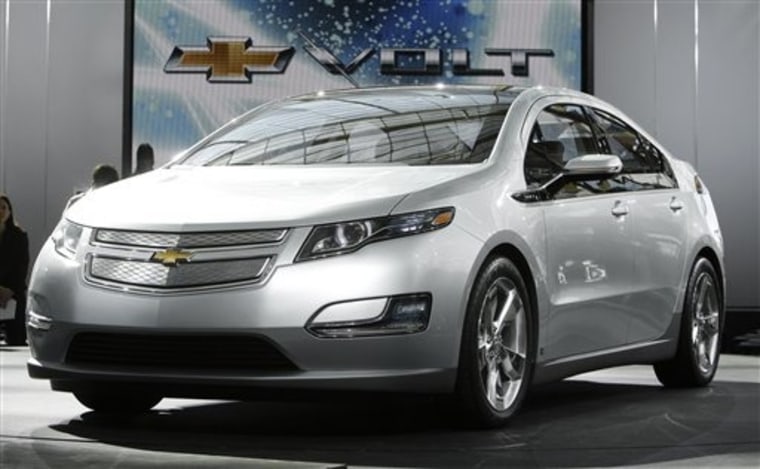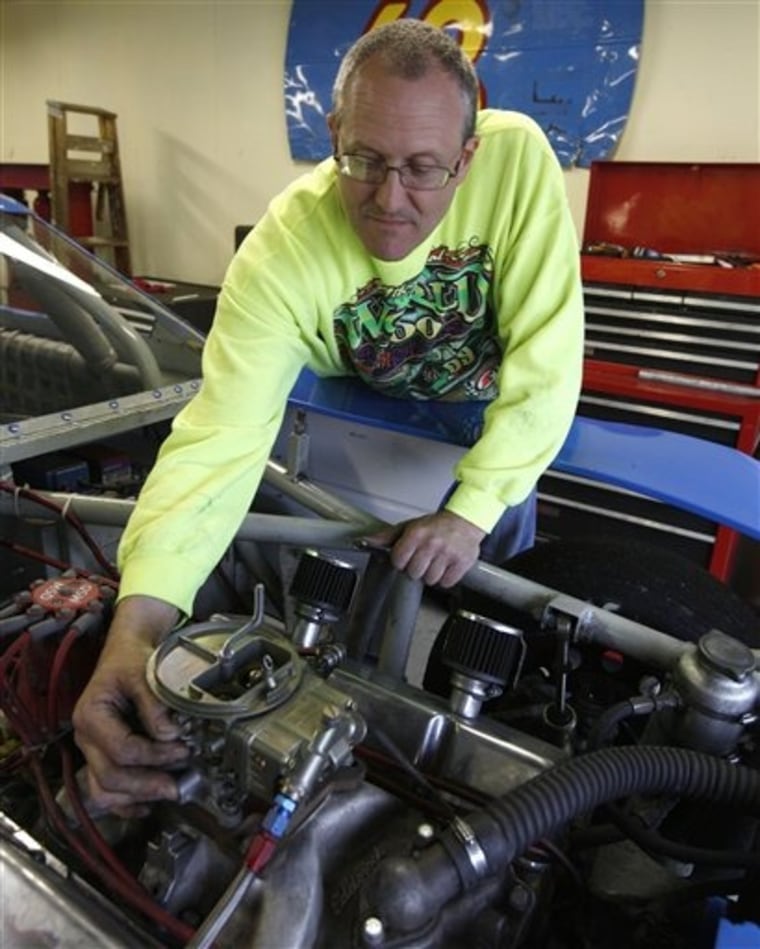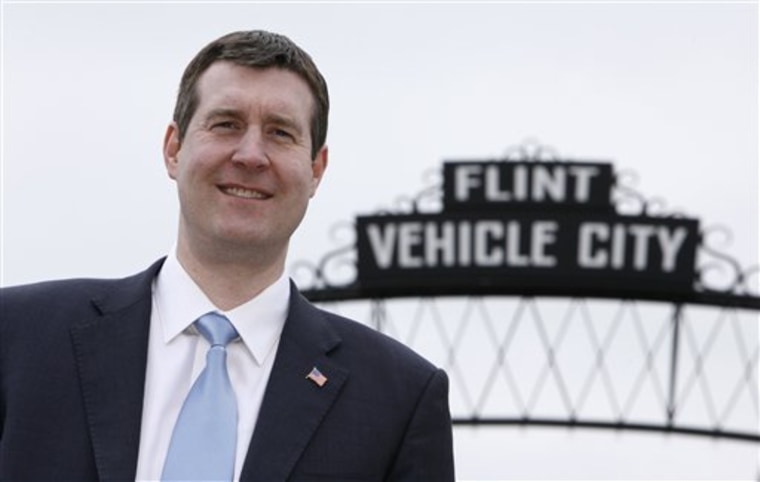He stands all day, bent over noisy machines, cutting giant sheets of steel and feeding them into monster-sized presses so powerful the concrete floor rumbles beneath his size-16 feet.
This is how Steve Prucnell builds cars. In 22 years, the parts haven't changed much. A car's a car.
But then another project came along, something totally different.
After decades of building hundreds of cars — everything from Corvettes to Saturns to Silverados — Prucnell took a giant leap into the future, joining the team that built test models of the Chevy Volt, General Motors' new electric car. It's a high-risk, high-profile venture and Prucnell is understandably nervous.
Maybe it's the 13 foreclosure signs that popped up on his street. Or turning 50 in a struggling industry. Or working for a company that needed a $52-billion loan from the U.S. Treasury to stay alive. Whatever the reason, Prucnell is keeping his fingers crossed, hoping America is ready for a new kind of love affair — battery included.
The Volt could help usher in a new generation of electric cars, but there's more at stake here than a technological breakthrough: The fate of GM and its workers. The future of a beleaguered state. And, maybe, in some larger sense, the image of all U.S. autoworkers, eager to prove they have what it takes to compete on the global stage.
The moment of truth is coming, and Steve Prucnell feels the pressure.
"If this doesn't fly, what's left for GM?" he asks, his 6-foot-6 frame hunched in a chair in the union hall near the GM Tech Center. "Wall Street is going to say, 'We knew they couldn't dig themselves out of the hole.'"
There was, Prucnell says, a different vibe building the Volt. It wasn't just the intense scrutiny from above. It was the anxiety down below, on the shop floor.
"I don't want to say that we worked harder on this," Prucnell says. "I think we worked a lot smarter. I mean everybody was on their 'A' game. It wasn't, "No, that's good enough.' It was, 'We want to make sure we're perfect.'"
"We know the Volt is the last hurrah for GM," he adds. "It's either do or die."
Spotlight on Volt
Roam the state of Michigan, and you will hear the same insistent optimism:
The Volt is crucial. So much depends on this car. It cannot fail.

This is a state that talks about becoming more than an auto capital, but cars have been its identity, its lifeblood. It's the place where Henry Ford's name graces a college, a hospital and a museum; where Walter Reuther Freeway honors the revered United Auto Workers leader; where Pontiac was an Indian warrior and then a town before gaining fame as a car.
So when the car industry tanks, the crisis is financial, personal and even existential.
"Detroit," declares Mike Smith, head of the Reuther Library, "has two choices: Remake itself. Or die on the vine."
He pauses. "We HAVE to reinvent ourselves."
Notice Smith uses Detroit not to refer to the city, but as a synonym for the auto industry. It's typical of a world where folks discuss V6 engines and powertrains with the same ease that Hollywood producers talk about movie grosses.
So what can a single car — one touted as revolutionary but still untested by the public — mean in a state that has hemorrhaged jobs, leaving some cities with Hoover-like jobless rates edging toward 30 percent?
Maybe a lot, according to Smith, a historian who was once a mechanic.
"If you're going to have an electric car and if the Volt turns out to be the leader of the pack, think what that means in sales, prestige, in reputation," he says. "This one is symbolic in the sense that it's going to speak to the prowess of the American auto industry — and GM itself."
And the spotlight will be white-hot.
"The Volt," he says, "is going to be the most watched production in the history of autos."
Pressure is on
Teri Quigley, the 22-year GM veteran who manages the sprawling Detroit-Hamtramck plant where the Volt will roll off the line, can already feel the heat.
"We have to execute flawlessly," she says. "A lot of pressure? Yeah. ... We've got one chance to do this right. My work force has heard me say this more than once: The world is really going to be watching."
GM is spending $336 million to prepare the factory, so it can build Volts on the same line as the Cadillac DTS and Buick Lucerne.
Quigley knows the risks that come with introducing a first-of-its kind car during a recession that has clobbered the auto industry. Car production in her plant plummeted from 120,500 in 2007 to 35,764 in 2009.
But the Volt, she says, could help restore luster to American cars — and the city.
"The whole view of what Detroit is like, what the auto industry is like — we have a unique opportunity to change that tarnished image," she says. "I'd like to change people's minds about what we do here."
Workers at Quigley's plant recently assembled six Volts, adding to 80 or so built by hand at GM's Tech Center. Some early models have been crash-tested or subjected to extremes: the 100-plus-degree desert of Death Valley, the 40-below freeze of Kapuskasing, Ontario, the 14,000-foot climb up Pikes Peak.
Others are being road-tested or plugged in the garages of GM engineers to get the kinks out before the cars hit the showrooms late this year.
Initially, the Volt will be available only in Michigan, California and Washington, D.C. GM won't reveal the price tag, though it's expected to be about $35,000 — not taking into account a $7,500 tax credit.
What will this buy?
A complex machine of more than 18,000 parts, none probably more important than the 400-pound, T-shaped lithium ion battery. It will give the car a range of up to 40 miles on one charge.
After that, a small gas-powered engine will kick in to generate electricity to power the car about 300 miles. The battery can be recharged by plugging it into an electrical outlet.

The Volt will largely be a Michigan production. GM is pouring $700 million into eight operations that will create the car. The dollars and work — battery packs in one place, engine generators in another — will be spread out: Warren. Hamtramck. Bay City. Grand Blanc. Brownstown Township. And Detroit and Flint, two cities that are the walking wounded of the cataclysm that has engulfed Michigan.
The state has lost 860,000 jobs in a decade, the majority since 2007. Gov. Jennifer Granholm recently noted the state has shed 78 percent of its auto manufacturing jobs in the last 10 years, as GM, Chrysler and more than 50 suppliers declared bankruptcy.
The Volt, she says, "symbolizes the new GM and the new Michigan." She predicts it will help the state become an incubator for thousands of jobs in the battery industry.
There have been modest signs of improvement, too, for U.S. automakers in recent months; GM, which has just announced its first quarterly profit in nearly three years, plans to invest nearly $900 million on five factories around the country.
Even so, the U.S. auto industry will never again generate one in six U.S. jobs, says Smith, the historian. Robots, automation and foreign competition have forever changed that.
And yet ... silver linings can be found in the smallest clouds.
"People in this area are looking for anything to say Michigan and its car industry can make it," he says. "That's the hope factor that drives a lot of us in Detroit. What if the electric car catches on? What if there are suddenly orders for 100,000 Volts? Now we're talking. GM will be making plenty of cars again and everybody here will be happy."
New life in Flint
Dayne Walling is accustomed to looking for silver linings; he's the mayor of Flint.
These days, he has 230 million reasons to be optimistic — the amount GM is investing in Volt projects in his city. Most of it will go to renovate a plant where about 200 workers — the number is expected to grow — will build a 1.4-liter engine for the Volt and Chevy Cruze compact.
It seems only natural that Flint has a hand in producing the Volt. It is, after all, a city steeped in history: the birthplace of GM, the home of the 44-day autoworkers sitdown strike that gave rise to the modern UAW, and the nation's carriage capital more than a century ago.
A sign arching over the main drag, Saginaw Street, heralds Flint as "Vehicle City."
A few hundred jobs, though, won't reverse the devastation in a city where more than one in four people are unemployed, thousands of homes stand shuttered and once vibrant factories are empty concrete shells, plundered by vandals and copper thieves.
Still, Walling, is looking for a meaningful way to remain positive.
"You can bemoan the glass that's half-empty or you can embrace the glass that's half-full," says the boyish-looking, 36-year-old mayor. "We're part of next generation of GM — and that demonstrates we're part of its future, not its past."
The past did have its moments of glory. In the 1950s and '60s, Flint bustled with 80,000 workers streaming into GM factories, creating traffic jams, backing up expressway exits.
A generation later, an entirely different story.
That was the era of massive layoffs depicted in Flint native Michael Moore's scathing documentary "Roger and Me," that took aim at Roger Smith, then GM's CEO. The film also mocked ill-conceived ideas to revitalize Flint, notably with AutoWorld, a Disney-like indoor theme park celebrating the car culture.
For the record, Walling admits he liked "Roger and Me" — an attitude he says isn't widely shared in Flint.
"I thought it was really funny and tragic," he says. "You're laughing and crying at the same time. I took it as a challenge ... to work against the odds and not just promote a better image but make this a more prosperous community."
Twenty years and a few recessions later, the job is even harder.
But here comes the Volt.
"It's the beginning," Walling says, "of a long transition from a Rust Belt city to one that's more green, has more technology and is more relevant to the 21st century."
‘It’s savior for us’
Kris Johns, an auto plant electrician, is making that transition himself.
He started as a young man at Flint. Now, 34 years later, he's part of the Volt engine launch team.
"It's savior for us," he says, simply. He is standing in Local 599's union hall, amid giant photos of Martin Luther King and Cesar Chavez, of United Farm Workers fame, reflecting the UAW's political activism of a bygone era.
At 55, Johns could retire. He reached the autoworkers' holy grail a few years ago: the 30-year-milestone that gives him a full pension. But he still wants to work.
GM has provided him a good life.
He bought his first house, for instance, at 23. He built a 4,100-square-foot home shaped liked a geodesic dome, helped his three kids through college, bought a truck, an 18-foot boat and a 28-foot camper trailer — and rents out 10 houses.
"Working around here you were the rich guys," Johns says. "We were well-paid, for blue-collar workers. We will not deny that. But we worked hard, too. We gave them their money's worth."
Even in its recent hard times, GM workers could rack up $100,000 a year — providing they worked a ton of overtime, sometimes seven days a week.
Johns knows autoworkers and GM have been bad-mouthed over the years; some if it, he feels has been unfair, but some justified.
"We've taken a pretty good beating. We developed a reputation for poor quality. We put out junk," he says, referring to some cars in the late '70s and early '80s. "People recognized it. It's taken awhile to get the public back."
On the cutting edge
An hour's drive away at the union hall next to the GM Tech Center, Steve Prucnell agrees.
"They let a lot go," he says, referring to the '80s. "I think that's what got them in trouble. I think their thinking was, 'Hey, we're No. 1. We're never going to be knocked off.' Toyota kicked our butt."
Prucnell stops to make a point. "That's just Steve's opinion," he says.
The result wasn't pretty. When Prucnell started working on the Volt last year, GM was bankrupt. A federal rescue was in question. And money was so tight, he says, workers scrimped on paper towels, hunkered down in coats when the furnace broke and wore their industrial gloves until they were tattered.
"We thought they're going to go out of business before we even finished (the Volt)," Prucnell says. "Even I had my doubts GM would have been here in 2010 — and I'm a positive person."
Prucnell says there was so much uncertainty, workers would joke that one day they might come in, swipe their ID entry cards, a red light would flash, the company would be out of cash and their jobs would be over. So each morning, there was tension. "I'd be standing there, swiping, saying 'Come on. Green. Green. Green,'" Prucnell says.
Amid the gallows humor, he had real fears about the future. "I thought, 'What am I going to do?'" Prucnell recalls. "Is a 50-year-old guy marketable? Not reallllly."

Prucnell has always loved cars. He tinkered with them as a kid with his dad, a Ford worker, and bought his first for $250 at age 15 (a '68 Ford Cougar junkyard special). He now spends Saturday nights with his wife, Mary, a former tech center apprentice, racing souped-up cars at the Flat Rock Speedway. (Mary, he notes, is definitely the better driver.)
Working on the Volt, he says, offered a different kind of thrill.
"It's cutting edge," he says. "It felt good to learn something again."
His metal model-making team produced about 195 different parts for every Volt, each one measured with precision and examined in great detail, often with bosses watching over their shoulders. "'Is it right?' I must have heard that a million times," Prucnell says.
Prucnell has since moved on to a new project — the Chevy Malibu. Some days, he sees test models of the Volt cruising around the tech center lot. He's eager to see them on the street.
"There's going to be a feeling of pride when it's running off the line," he says. "I'm really not nervous about that. We know it's going to be right."
Car of the future?
George McGregor, president of UAW Local 22 in Detroit, is more measured in his optimism.
The Volt, he says, will put his workers on the ground floor of a new enterprise, help them gain technological expertise and — he hopes — give them job security.
"Do I want it to work? Most definitely. MOST definitely. Now, do I have some reservations about battery cars? Definitely." McGregor lets loose a throaty laugh. "Definitely. ... For me, the jury is still out."

McGregor recalls the golden days in the 1960s when he arrived in Detroit. The city was thriving. So, too, were American cars. And auto jobs were plentiful.
McGregor found a job at GM just weeks after returning from Vietnam. A scrawny, baby-faced Army vet, he'd moved north from Memphis, confident he could earn more than the $46-a-week he was pulling in making ax handles.
It was a time where tail-finned Caddys and boat-like Lincolns glided down asphalt highways, gas was 34 cents a gallon and a sturdy back and a willingness to work were enough to land an auto job — and a ticket to the middle class. His first assignment was welding Cadillac seats in a sweltering, six-story factory.
Now, 42 years later, McGregor, a 64-year-old grandfather with a halo of silver hair, has adapted to $3-a-gallon gas and a dwindling auto empire that has shrunk his local from 6,000 members in the 1980s to 1,500 today.
So the Volt is mighty welcome.
"We're blessed to have it. We're going to do a tremendous job," McGregor vows, a trace of Tennessee still clinging to his raspy voice.
Not that he's ready to trade in his own wheels: McGregor drives one Cadillac (a 2008 candy-red CTS) and keeps another (a treasured 1977 DeVille) in his garage, a car he boasts has "real chrome bumpers — not plastic" and a working eight-track tape player.
Old habits, he says, die hard.
"I live in America and I live in a car city where the combustible engine was THE thing," McGregor says. "Americans love power. Fast cars. You understand? They LOOVVE large cars. Small cars, efficient cars? We're being forced into that now. If (drivers) just had a choice and gas was reasonable, it would be SUVs and large cars."
McGregor figures electric cars are part of the future, and he'd love it if Local 22 built each and every one. Still, that one question nags at him.
"Is this what the public really wants?" he asks, as if seeking reassurance.
"Hopefully," he says softly, leaning back. "Hopefully."
